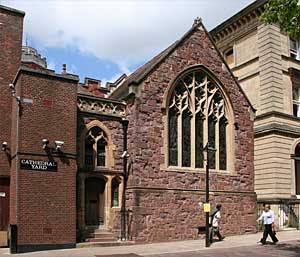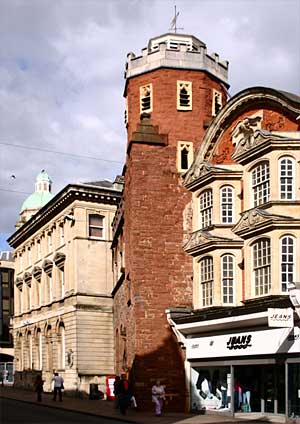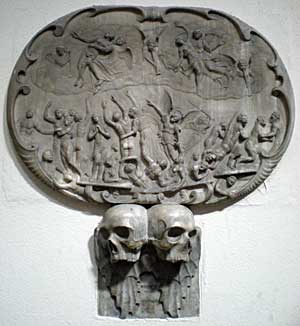
St Petrock's Church - High Street
Page updated 26 June 2009
 Nicholas Pevsner described St Petrock's Church with the
words "The interior is among the most
confusing of any church ... in England" This confusion
stems from a long history and it maybe the oldest church in Exeter,
with some
thinking it was founded by St Petrock, the 6th century Cornish saint.
Some sources are more conservative and date its founding to the
11th-century. It was one of twenty-nine churches which William the
Conqueror directed the City Provost to pay one silver penny out of the
public taxes. In 1191, the simple chancel, nave and perhaps a bell
tower was formally named St Petrock's by Bishop Marshall.
Nicholas Pevsner described St Petrock's Church with the
words "The interior is among the most
confusing of any church ... in England" This confusion
stems from a long history and it maybe the oldest church in Exeter,
with some
thinking it was founded by St Petrock, the 6th century Cornish saint.
Some sources are more conservative and date its founding to the
11th-century. It was one of twenty-nine churches which William the
Conqueror directed the City Provost to pay one silver penny out of the
public taxes. In 1191, the simple chancel, nave and perhaps a bell
tower was formally named St Petrock's by Bishop Marshall.
Close to the centre of the city and the Guildhall, St Petrock's has had an important place in the lives of many city mayors. In 1286, St Petrock's became a superior postern entrance into Cathedral Yard and had to be shut at night – in other words, it was one of the seven gates to Cathedral Yard.
The church was also used to support the poor and in 1411 a parishioner gave funds in his will for 100 poor persons in the parish be properly clothed. Two years later, in 1413 the nave was extended and a century later, it was further enlarged and named the 'Jesus Aisle" which is distinguished by a still existing row of columns. The bell tower was rebuilt and the church re-consecrated in 1513 by Thomas Chard acting as Suffragan Bishop for the elderly Bishop Oldham while the octagonal turret was added in 1737.
In 1548, Alexander Awdyan left 3s 4d annually for a sermon to be given at St Petrock's and St Saviours. The reformation saw the internal ornamentation removed, replaced in Queen Mary's time and then removed again during the reign of Elizabeth I along with the introduction of the new English Prayer Book.
St Petrock's was enlarged in 1587 and again in 1828 with a major restoration when it was reseated. In 1881, the chancel was converted into a baptistry, and a new chancel, organ chamber and vestry built on the side next to Cathedral Yard. Bishop Temple preached the sermon when the church was re-opened on 22 November 1881.
The register dates from 1538 after the order from Thomas Cromwell, while accounts written on parchment skins measuring 62 cms by 27 cms, cover the years 1425 to 1590. The church was used as a library for a time with the large volumes chained to the walls. Whites directory of 1850 said of the church "The sacramental plate is very superb, and comprises two cups dated 1572 and 1640, and two flagons, dated 1692. In the tower are six bells. The rectory is consolidated with that of St. Kerrian. St. Petrock was one of the early propagators of christianity, and gave name to Petrockstowe, in Devonshire."
The church was hidden from the High Street by inappropriate buildings for two centuries, when in 1905, they were removed to widen the High Street and expose the church to view once again. There had been a proposal to demolish the tower as part of the road widening, but the rector, Rev. W David, led a campaign to prevent it happening. On 10 January 1935, St Petrock was united with St George and St John into the parish of St Mary Major, while much of the parish land was absorbed by St Mary Steps.
The Bells
The peal of six bells, said to be the lightest in Devon, are now the centre of a healthy training centre for new ringers. Three bells are dated 1677, 1693 and 1742. The bells are inscribed:
- John Coombes, Clerk, A. Rudhall, founder, 1742
- John Dell, Roger Prous, Wardens; Richard Strang, Clerk, 1693. I. S. John Daley, Gent
- Johannes est nomen ejus (with the arms of Henry V)
- T. P. (initials of Thomas Pennington the bell founder)
- Soli Deo detvr gloria, 1677.
- No markings
During the 1990's, the church has continued working with the poor by opening a centre for the homeless.
Roll of Honour - 1914-1918
To The Glory Of God & In Ever Loving And Grateful Remembrance Of The Men Of St Petrock's & S Kerrian's Who Gave Their Lives For Right & Freedom In The Great War 1914-1918 This Tablet Was Erected & Our Ancient Bells Were Restored.
E Branch
C
E Brook
E
T Evans
J Evans
W Gammon
E A Greek
H de L Hardy
A J
Isaac
H
J Lascelles
W Lear
W H Morrish
H H Northcott
Sources:Exeter Churches by Beatrix Cresswell and History of St Petrock's by Robert Dymond. Plan by Maurice Swansborough., the Times 1927.

St Petrock from Cathedral Yard.
 St Petrock from the High Street.
St Petrock from the High Street.
 A monument in St Petrock's musing on
eternity.
A monument in St Petrock's musing on
eternity.
│ Top of Page │